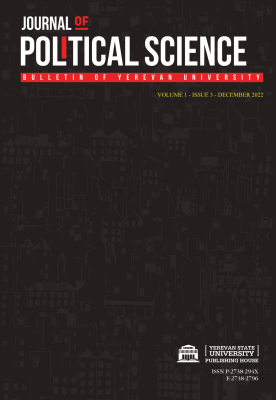Gender-Sensitive Approaches in Confidence- and Security-Building Measures
DOI:
https://doi.org/10.46991/JOPS/2022.1.3.051Keywords:
Gender-sensitive approach, confidence, security, Europe, OSCE, women’s military service, security sector, peaceAbstract
The paper examines the existing issues and proposes new outlook on the solutions for incorporating gender-sensitive approaches in the sphere of arms control and confidence- and security-building measures in Europe (CSBMs). Based on a thorough consideration of the current practices and relevant documentation, the notion of gender-positive approach is introduced, while a set of particular measures for improving gender mainstreaming in the security sector is suggested. To assess adequately the degree of streamlining the OSCE’s gender-related principles at local level and underline the existing gaps between theory and practice, short interviews were conducted with former and current female officers and specialists, engaged in human rights promotion in the defence and security structures. The paper concludes with the diagram offering interconnected steps to the efficient engagement of women in CSBMs.
References
Charlesworth, Hilary. 2005. “Not Waving but Drowning: Gender Mainstreaming and Human Rights in the United Nations.” Harvard Human Rights Journal 18: 1-18.
Council of Europe. 2015. European Social Charter. Collected texts (7th edition). January 2015. Accessed November 1, 2022. https://rm.coe.int/168048b059.
Davis, Laura. 2018. Kissing the frog: Gender equality in EU conflict prevention and other fairy tales. EPLO. Accessed November 1, 2022. https://eucivcap.files.wordpress.com/2018/05/eu-civcap_deliverable_3-4_web.pdf.
DCAF, OSCE/ODIHR, UN Women. 2019. “Security Sector Governance, Security Sector Reform and Gender.” In: Gender and Security Toolkit. Geneva: DCAF, OSCE/ODIHR, UN Women.
Diaz, Pablo Castillo, and Simon Tordjman. 2012. Women’s Participation in Peace Negotiations: Connections between Presence and Influence. New York: UN Women. Accessed November 1, 2022. https://peaceoperationsreview.org/wp-content/uploads/2015/11/womens_partcipation_peace.pdf.
Myrttinen, Henri, and Megan Daigle. 2017. When merely existing is a risk: Sexual and gender minorities in conflict, displacement and peacebuilding. London: International Alert.
OSCE. 1990. Treaty on Conventional Armed Forces in Europe. Accessed November 1, 2022. https://www.osce.org/files/f/documents/4/9/14087.pdf.
OSCE. 1994. Code of Conduct on Politico-Military Aspects of Security. Programme for Immediate Action Series, No.7, DOC.FSC/1/95, December 3, 1994. Accessed November 1, 2022. https://www.osce.org/files/f/documents/5/7/41355.pdf.
OSCE. 2011. Vienna Document On Confidence-And Security-Building Measures. Accessed November 1, 2022. https://www.osce.org/files/f/documents/a/4/86597.pdf.
OSCE. 2013. Training manual for organizing and conducting a course on human rights and fundamental freedoms in the armed forces. OSCE Office in Yerevan.
OSCE. 2018. Gender in military operations: Guidance for military personnel working at tactical level in Peace Support Operations. Vienna, Austria. Accessed November 1, 2022. https://www.osce.org/secretariat/401705.
OSCE. 2019. Understanding the Role of Gender in Preventing and Countering Violent Extremism and Radicalization That Lead to Terrorism Good Practices for Law Enforcement. Vienna, Austria. Accessed November 1, 2022. https://www.osce.org/secretariat/420563.
OSCE/ODIHR 2019. Gender, Diversity and Justice: Overview and Recommendations. Warsaw. Accessed November 1, 2022. https://www.osce.org/files/f/documents/3/4/419840_0.pdf.
OSCE/ODIHR. 2008. Handbook on Human Rights and Fundamental Freedoms of Armed Forces Personnel.Warsaw: OSCE/ODIHR.
OSCE/ODIHR. 2020. International and Regional Laws and Instruments related to Gender Equality and the Security and Justice Sector: Annex. DCAF, OSCE/ODIHR, UN Women. Accessed November 1, 2022. https://www.osce.org/odihr/461926.
PACE. 2016. “Resolution 2120 (2016).” Accessed September 1, 2022. https://pace.coe.int/en/files/22939/html.
UN Women. 2018. “Turning promises into action: Gender equality in the 2030 Agenda for Sustainable Development”, New York: UN Women.
United Nations. 1979. “The Convention on the Elimination of All Forms of Discrimination against Women (CEDAW).” Accessed September 1, 2022. https://www.un.org/womenwatch/daw/cedaw/text/econvention.htm.
United Nations. 2000. “Security Council resolution 1325 (2000)”. Accessed September 1, 2022. https://documents-dds-ny.un.org/doc/UNDOC/GEN/N00/720/18/PDF/N0072018.pdf?OpenElement.
Downloads
Published
Issue
Section
License
Copyright (c) 2022 Hakob Gabrielyan

This work is licensed under a Creative Commons Attribution-NonCommercial 4.0 International License.



